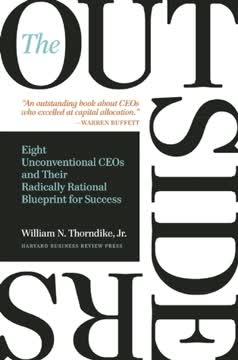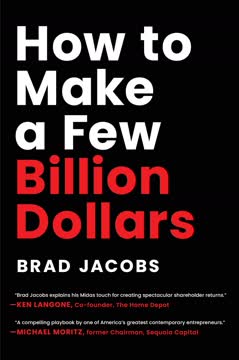Key Takeaways
1. Power is the key to creating lasting business value
Power: the set of conditions creating the potential for persistent differential returns
Power drives value. In business, Power is the ability to generate sustained, above-average profits despite competitive pressures. It consists of two elements: a Benefit that materially improves cash flow, and a Barrier that prevents competitors from arbitraging away this advantage. The Fundamental Equation of Strategy illustrates this concept:
Value = Market Size * Power
Where:
- Market Size = Current market size * Discounted growth factor
- Power = Long-term average market share * Long-term average differential margins
Companies without Power are vulnerable to competitive forces that erode profitability over time. Intel's contrasting experiences in memory chips (no Power) and microprocessors (significant Power) demonstrate the critical importance of establishing and maintaining Power for long-term success.
2. The 7 Powers: Scale Economies, Network Economies, Counter-Positioning, Switching Costs, Branding, Cornered Resource, and Process Power
The 7 Powers framework covers all attractive strategic positions, it is not simplistic, while its unitary focus on Power makes it sufficiently simple to be learned, retained and used by any business person.
Understanding the 7 Powers. Each Power type represents a unique way to create and sustain competitive advantage:
- Scale Economies: Larger production volumes lead to lower per-unit costs
- Network Economies: Value increases as more users join the network
- Counter-Positioning: A new, superior business model that incumbents can't easily adopt
- Switching Costs: Customers face significant costs when changing suppliers
- Branding: Customers willingly pay more for a perceived higher value
- Cornered Resource: Exclusive access to a valuable asset
- Process Power: Superior internal processes that are difficult to replicate
These Powers are not mutually exclusive; companies can leverage multiple types simultaneously. For example, Netflix combined Scale Economies and Network Economies to dominate the streaming market.
3. Strategy must provide a route to continuing Power in significant markets
strategy: a route to continuing Power in significant markets
The Mantra of strategy. A successful strategy must fulfill three key requirements:
- Route: A clear path to establishing and maintaining Power
- Continuing: The ability to sustain Power over time
- Significant markets: Targeting markets large enough to generate substantial value
This definition emphasizes that strategy is not just about short-term gains or operational excellence. Instead, it focuses on creating durable competitive advantages in markets with significant potential. Companies must continuously adapt and layer on different sources of Power as their business progresses to maintain their strategic position.
Examples of successful strategies:
- Apple's ecosystem of devices and services
- Amazon's relentless focus on customer experience and logistics
- Google's dominance in search and digital advertising
4. Invention is the mother of Power and drives market size
"'Me too' won't do" guides the creation of Power.
Invention fuels growth and Power. The first step in establishing Power is creating something new and valuable. This can be a product, process, business model, or brand. Invention serves two crucial purposes:
- Opens the door to Power by creating unique advantages
- Drives market size by offering compelling value to customers
There are three paths to achieving compelling value:
- Capabilities-led: Leveraging existing strengths to create new products (e.g., Adobe Acrobat)
- Customer-led: Solving a known but unmet customer need (e.g., Corning's fiber optics)
- Competitor-led: Offering a significantly better alternative to existing solutions (e.g., Sony PlayStation)
Successful inventions often elicit a "gotta have" response from customers, driving rapid adoption and market growth. This initial period of high flux and uncertainty is critical for establishing certain types of Power.
5. The Power Progression: Timing is crucial for establishing different types of Power
Different Power types present the opportunity for first establishing a Barrier at different times in the development of your business.
The Power Progression framework. This tool helps businesses understand when different types of Power become available:
-
Origination (pre-takeoff):
- Counter-Positioning
- Cornered Resource
-
Takeoff (rapid growth):
- Scale Economies
- Network Economies
- Switching Costs
-
Stability (slower growth):
- Process Power
- Branding
Understanding this progression is crucial for recognizing and seizing opportunities at the right time. For example, Scale Economies must be established during the takeoff phase when market share can be gained at favorable terms. Missing this window can result in permanent disadvantage, as seen in Apple's fumble with the Apple III during the critical takeoff period of personal computers.
6. Operational excellence is necessary but not sufficient for lasting success
Operational excellence by itself is not enough.
Beyond operational excellence. While crucial for day-to-day success, operational excellence alone does not guarantee long-term profitability. This is because improvements in operations can often be imitated by competitors, leading to industry-wide adoption and erosion of any temporary advantages.
Key distinctions:
- Operational excellence: Continuously improving existing processes and products
- Strategic advantage: Creating and maintaining Power that resists competitive arbitrage
However, in high-flux situations like the takeoff stage, excellent execution can be highly strategic. Intel's Operation Crush, which secured the IBM PC contract, demonstrates how operational excellence can be decisive in establishing long-term Power during critical periods.
Areas where operational excellence is crucial but not sufficient:
- Product quality improvements
- Cost-cutting initiatives
- Customer service enhancements
- Supply chain optimizations
7. Leadership plays a crucial role in establishing Power and navigating high-flux situations
In moving from Statics to Dynamics, scope is broadened considerably.
Leadership in dynamic environments. While good management cannot overcome a lack of Power in stable markets, leadership is fundamental in establishing Power during high-flux periods. Leaders must:
- Recognize emerging opportunities for Power
- Make bold decisions in uncertain environments
- Rally the organization to execute effectively during critical periods
Examples of crucial leadership moments:
- Bob Noyce's decision to pursue microprocessors at Intel
- Andy Grove's aggressive Operation Crush to secure the IBM PC contract
- Reed Hastings' pivot to streaming and original content at Netflix
In these dynamic situations, leaders must craft strategy through intelligent adaptation over extended periods, facing daunting uncertainty. This process is more akin to entrepreneurship than planning, requiring a keen understanding of the 7 Powers and the ability to recognize and seize fleeting opportunities for establishing Power.
Last updated:
FAQ
What's "7 Powers: The Foundations of Business Strategy" about?
- Overview of the book: "7 Powers" by Hamilton Wright Helmer is a comprehensive guide to understanding the fundamental determinants of business strategy and value creation.
- Core concept: The book introduces the concept of "Power," which refers to the conditions that create the potential for persistent differential returns in business.
- Framework: Helmer outlines seven types of strategic power that businesses can leverage to gain a competitive advantage.
- Purpose: The book aims to provide a practical framework for business leaders to identify, create, and maintain strategic advantages in their industries.
Why should I read "7 Powers: The Foundations of Business Strategy"?
- Strategic insights: The book offers deep insights into the nature of competitive advantage and how it can be achieved and sustained.
- Practical application: Helmer provides actionable strategies that can be applied to real-world business scenarios, making it valuable for business leaders and strategists.
- Comprehensive framework: The seven powers framework is a unique and comprehensive approach to understanding business strategy.
- Expert endorsements: The book is praised by industry leaders like Reed Hastings and Daniel Ek, highlighting its relevance and impact.
What are the key takeaways of "7 Powers: The Foundations of Business Strategy"?
- Power is essential: The book emphasizes that having at least one of the seven powers is crucial for a business to achieve sustainable competitive advantage.
- Invention is key: Invention is the first step towards creating power, whether through products, processes, or business models.
- Timing matters: The book outlines the importance of timing in establishing power, particularly during the takeoff stage of a business.
- Strategic focus: Businesses must focus on creating compelling value and identifying opportunities for power to succeed in the long term.
What are the seven powers outlined in "7 Powers: The Foundations of Business Strategy"?
- Scale Economies: Achieving lower per-unit costs with increased production volume.
- Network Economies: Increasing the value of a product as more people use it.
- Counter-Positioning: Adopting a superior business model that incumbents cannot mimic without damaging their existing business.
- Switching Costs: Creating value loss for customers who switch to a competitor.
- Branding: Building a durable attribution of higher value to a product through historical information about the seller.
- Cornered Resource: Gaining preferential access to a coveted asset that enhances value.
- Process Power: Developing complex processes that competitors cannot easily replicate.
How does Hamilton Helmer define "Power" in "7 Powers: The Foundations of Business Strategy"?
- Definition: Power is defined as the set of conditions creating the potential for persistent differential returns.
- Components: It requires both a benefit, which improves cash flow, and a barrier, which prevents competitors from arbitraging away the benefit.
- Strategic importance: Power is the core concept of strategy and is essential for creating business value.
- Long-term focus: The book emphasizes that power must be sustainable to ensure long-term competitive advantage.
What is the "Fundamental Equation of Strategy" in "7 Powers: The Foundations of Business Strategy"?
- Equation: The equation is NPV = M0 g s m, where NPV is the net present value of expected future free cash flow.
- Components: M0 represents current market size, g is the discounted market growth factor, s is long-term market share, and m is long-term differential margin.
- Purpose: This equation links strategy to business value by quantifying the impact of market size and power.
- Strategic focus: It highlights the importance of both market scale and power in determining business value.
How does "7 Powers: The Foundations of Business Strategy" address the role of invention in strategy?
- Invention as a starting point: The book emphasizes that all power starts with invention, whether in products, processes, or business models.
- Creating value: Invention is crucial for creating compelling value that drives market size and opens opportunities for power.
- Strategic differentiation: "Me too" strategies won't suffice; businesses must innovate to achieve a competitive edge.
- Guidance for leaders: The book provides a framework for leaders to identify and leverage invention to establish power.
What is the "Power Progression" in "7 Powers: The Foundations of Business Strategy"?
- Concept: The Power Progression maps when power must be established by power type, indicating the timing of strategic opportunities.
- Stages: It divides the business lifecycle into origination, takeoff, and stability stages, each with different power opportunities.
- Strategic timing: The progression helps businesses understand when to focus on different types of power to maximize value.
- Practical application: It serves as a guide for leaders to align their strategic efforts with the right timing for power establishment.
What are some of the best quotes from "7 Powers: The Foundations of Business Strategy" and what do they mean?
- "Making a small number of decisions wisely is far more important than making a lot of decisions correctly." This quote emphasizes the importance of strategic focus and prioritization in business decision-making.
- "If you don’t get your strategy right, you are at risk." This highlights the critical role of strategy in ensuring business success and sustainability.
- "Strategy serves best not as an analytical redoubt, but rather in developing the 'prepared mind' of those on the ground." This underscores the practical application of strategy in real-world business scenarios.
- "The first cause of a strategy is invention." This quote stresses the importance of innovation as the foundation of strategic advantage.
How does "7 Powers: The Foundations of Business Strategy" differentiate between Strategy Statics and Strategy Dynamics?
- Strategy Statics: Focuses on understanding strategic position at a single point in time, emphasizing the importance of power.
- Strategy Dynamics: Explores the development of strategy over time, addressing how businesses can establish power.
- Complementary perspectives: Both statics and dynamics are essential for a comprehensive understanding of business strategy.
- Practical application: The book provides insights into how businesses can navigate both static and dynamic aspects of strategy to achieve success.
How can "7 Powers: The Foundations of Business Strategy" be applied to real-world business scenarios?
- Framework for analysis: The seven powers framework can be used to analyze and assess a company's strategic position and opportunities.
- Guidance for leaders: Business leaders can use the book's insights to identify and create strategic advantages in their industries.
- Practical strategies: The book offers actionable strategies for leveraging power to achieve competitive advantage and business value.
- Case studies: Real-world examples and case studies in the book illustrate how the concepts can be applied in practice.
What is the significance of the "7 Powers" framework in "7 Powers: The Foundations of Business Strategy"?
- Comprehensive approach: The framework provides a comprehensive approach to understanding and achieving strategic advantage.
- Exhaustive coverage: It covers all attractive strategic positions for businesses, ensuring no viable strategy is overlooked.
- Practical tool: The framework serves as a practical tool for business leaders to navigate complex strategic landscapes.
- Enduring relevance: The seven powers are applicable to businesses across industries and stages, making the framework enduringly relevant.
Review Summary
7 Powers receives mixed reviews, with ratings ranging from 2 to 5 stars. Many readers praise its concise framework for business strategy, highlighting its practical applications and real-world examples. Critics argue that the content is not groundbreaking and relies heavily on existing concepts. Some appreciate the mathematical approach, while others find it unnecessary. The book's focus on seven key strategic positions (powers) is generally well-received, though some readers desire more depth and case studies. Overall, it's considered a valuable resource for those interested in business strategy.
Similar Books










Download PDF
Download EPUB
.epub digital book format is ideal for reading ebooks on phones, tablets, and e-readers.




